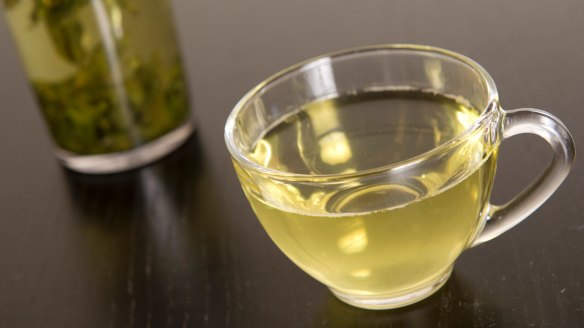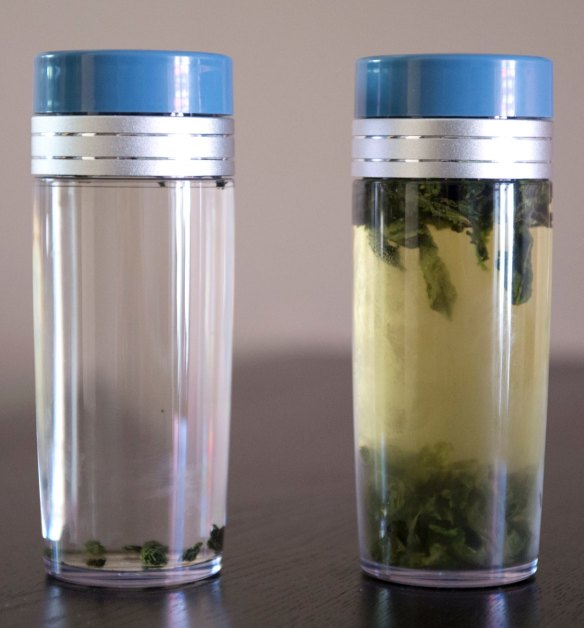How to make cold-brew tea

- VIDEO: Join tea expert Hannah Dupree as she demonstrates how to add further depth and structure to spirits and some fabulous new ways to use tea.
Tea has been consumed in many parts of the world for hundreds of years, but iced tea is far more contemporary and is believed to have evolved from the alcoholic tea punches served in England in the 19th century.
In America its popularity can be traced to the St Louis Fair of 1905, when tea merchant Richard Blechynden, charged with overseeing the tea pavilion and faced with a blistering hot day and few customers, decided to serve his tea over ice in glasses.

Today iced tea or "sweet tea" is the beverage of choice in the American south, where it is even offered at McDonald's outlets.
The drink hasn't been embraced as fervently in Australia. There are only a few brands of ready-to-drink iced tea in the market and all, like their American counterparts, are on the super-sweet side.
Tea educator and business owner May King Tsang says if she ever buys iced tea she will go to an Asian supermarket for unsweetened Japanese iced tea, or Taiwanese or Chinese versions.
“The oolong is delicious, but green iced teas can sometimes be a bit bitter and it may put you off if you're not accustomed to it,” Tsang says.
Tsang prefers to make her own cold-brew tea at home. While some people like to use boiling water and then cool the brew using ice, Tsang says this method can result in a bitter tasting tea. "People often add ice because they need to dilute a poor-tasting tea." Tsang says using cold water and allowing the tea leaves to steep over a long period produces a more consistent, superior flavour.
Tsang confesses she does not use ice at all in her cold-brew tea. The term cold-pressed tea, or cold fusion tea, is sometimes used to describe this method of making tea. Tsang says she uses the term "cold-pressed" because it sounds more appealing than "cold-brewed" tea.
Cold-brew teas can be made with any type of tea, but the result will only be as good as the tea you put in it. If you want a fruity tea, add real fruits to enhance or complement the taste, Tsang says.
“For a natural floral or fruity tea, try jasmine tea (such as Jasmine Buddha Tears) or osmanthus oolong. Osmanthus is a traditional Chinese flower that has hints of apricot. Or try tea that has no fruit or herb added to it, such as Tie Guan Yin (Iron Goddess of Compassion, often referred to as Iron Goddess of Mercy), with a natural floral sweetness reminiscent of orchids, which makes an absolutely delightful cup.”
According to Tsang, French Earl Grey is becoming as popular as the conventional Earl Grey for making iced tea.
“It is the addition of roses that help to cut through the citrus note of the bergamot oil," she says.
Tsang also recommends Stockholm blend; a black tea with citrus, flowers and fruits added to it.
If you prefer your iced tea to have a natural sweetness, Tsang recommends Daintree vanilla tea, which is naturally sweet.
“Generally, most vanilla teas are artificially flavoured and can often taste like chewing on perfume, because the intent is to mask the low quality of the tea under the (artificial) vanilla flavour," she says. "But the tea and the vanilla in this (both grown in tropical north Queensland) are well balanced and don't overpower each other. It's full of natural sweetness but with a robustness from the black tea.”
Loose leaf tea is preferable, because the teas you find in the traditional square tea bags are typically of the lowest quality. However, the pyramid shaped bags where you can see the loose leaf tea, flowers and herbs that have been added into the bag can make a great iced tea.
Why cold-brew?
Many people make iced-tea by making up a traditional tea brew with boiling water, but they double the amount of tea and then add a large amount of ice and cold water to both dilute the concentrate and to cool the tea before popping it into the fridge. However, with this method, the tannins are more likely to come through, imparting a bitter note. This method is also prone to producing inconsistent results.
Try cold-pressed tea instead. As with cold-pressed coffee, this method is time consuming. However, the process is simple, needs very little preparation and it is certainly worth the wait.
To make cold-brew tea
1. Take a standard-sized empty water bottle.
2. Add approximately one teaspoon of tea leaves directly into the water bottle. There is no need for complicated infusers.
3. Add freshly drawn water from the tap (or of you live in a hard water area, filtered water) into the water bottle.
4. Screw the bottle top on, put it in the fridge and let the water and tea make magic together. Leave overnight, or for at least six to eight hours, for the perfect iced tea.
Straining
Tsang says quality loose leaf tea, such as a tightly rolled oolong, tends to sink to the bottom of the bottle so there is no need to get rid of the leaves. But for smaller leafed tea, or a lower-quality leaf where there are many small particles, it may be a good idea to use a tea strainer and pour the tea from one container to another.
To ice, or not to ice?
If you want to pour your cold-brew tea over ice, do so - but be aware that you will dilute the flavour and may need to add more leaves at the beginning.
Sweetening cold-brew tea
Tsang prefers to use honey rather than sugar to sweeten her cold-pressed tea, and advocates raw sugar rather than refined white sugar. If using honey, experiment. "Certain honeys work well with some teas but don't for others," explains Tsang. For example, a tea with floral notes will work well with a similar-flavoured honey. Generally, teas with sweet notes already (such as vanilla) work better with sweeterners. Honey with more depth would pair with a delicate yet robust tea such as a lightly oxidised oolong or a white tea such as Bai Mu Dan (white peony).
Fruit tea
Add your fruit of choice to your tea brew a couple of hours before serving. What you choose to add depends on the type of fruit. If using a tea with a citrus note, such as Earl Grey, then add slices of orange to your cold-pressed tea. If your tea has a sweeter fruit note to it (such as in Tie Guan Yin or Iron Goddess of Compassion), adding slices of peaches or plum might work well. It's up to you whether to leave the fruit in the tea when serving.
May King Tsang is the owner of MayKing Tea. She runs regular tea appreciation classes.